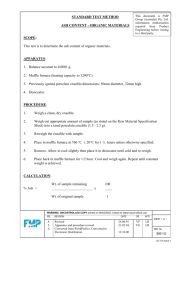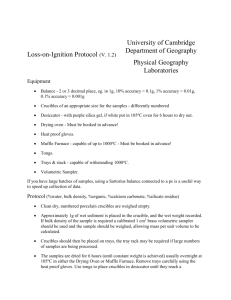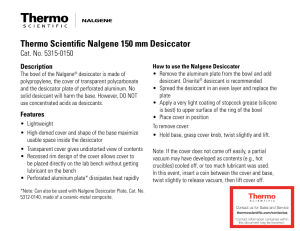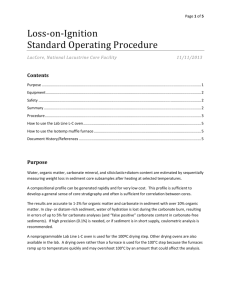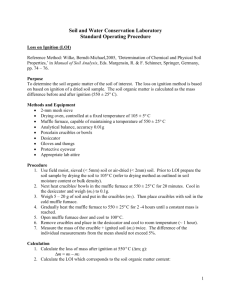Direct Estimation of Organic Matter by Loss on Ignition: Methods
advertisement
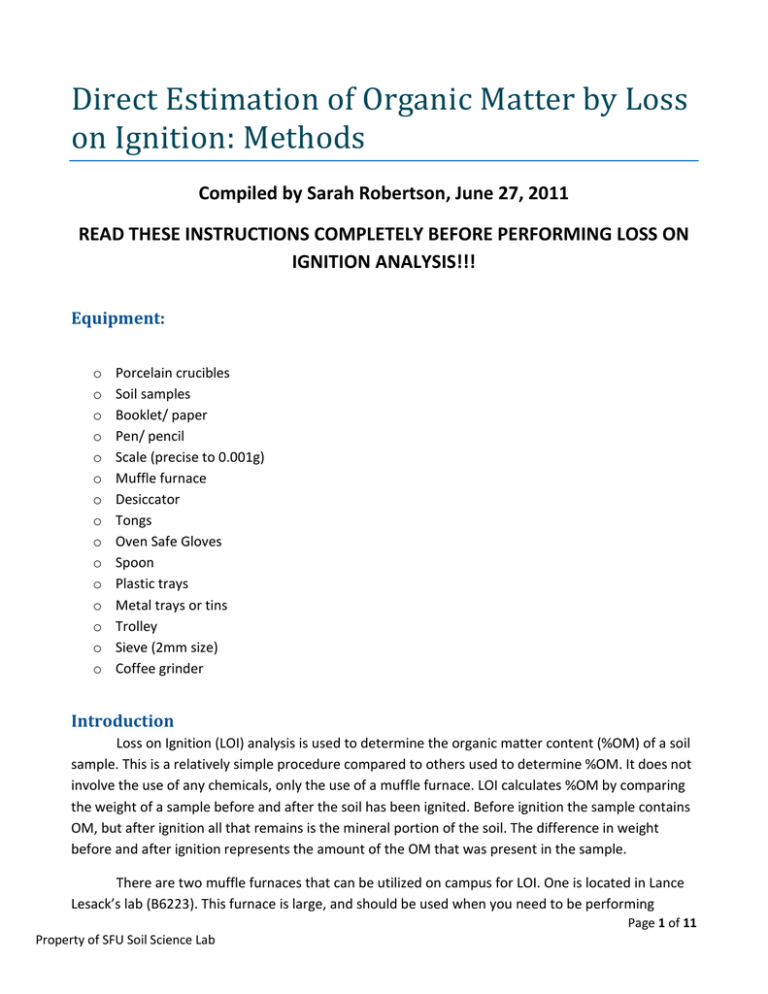
Direct Estimation of Organic Matter by Loss on Ignition: Methods Compiled by Sarah Robertson, June 27, 2011 READ THESE INSTRUCTIONS COMPLETELY BEFORE PERFORMING LOSS ON IGNITION ANALYSIS!!! Equipment: o o o o o o o o o o o o o o o Porcelain crucibles Soil samples Booklet/ paper Pen/ pencil Scale (precise to 0.001g) Muffle furnace Desiccator Tongs Oven Safe Gloves Spoon Plastic trays Metal trays or tins Trolley Sieve (2mm size) Coffee grinder Introduction Loss on Ignition (LOI) analysis is used to determine the organic matter content (%OM) of a soil sample. This is a relatively simple procedure compared to others used to determine %OM. It does not involve the use of any chemicals, only the use of a muffle furnace. LOI calculates %OM by comparing the weight of a sample before and after the soil has been ignited. Before ignition the sample contains OM, but after ignition all that remains is the mineral portion of the soil. The difference in weight before and after ignition represents the amount of the OM that was present in the sample. There are two muffle furnaces that can be utilized on campus for LOI. One is located in Lance Lesack’s lab (B6223). This furnace is large, and should be used when you need to be performing Page 1 of 11 Property of SFU Soil Science Lab analysis on a significant number of samples. The furnace is capable of holding ~50 samples, but with the use of the two desiccators located in the lab you will likely only be able to analyze 20 samples. The other furnace is located in the soil science lab (RCB6303). This furnace is considerably smaller, and you will only be able to analyze a maximum of 4 samples. For LOI you can either place samples in porcelain crucibles, or in small metal tins. There is no significant effect to the use of either, but we currently only have 20 crucibles. Therefore if you wish to analyze more than 20 samples at a time you may want to use metal tins for consistency in analysis. When performing this analysis it is important to keep track of your samples after you’ve placed them in either the crucibles or tins. If you are using the crucibles they may have a label either carved in the side or written on the bottom. You are free to re-label them if you wish. If you are using the metal tins note that labels written in pen on the tins will survive the oven-drying, but will not survive being placed in the muffle furnace. The temperature gets very high and burns off the labels. If you are using metal tins in the muffle furnace you may etch labels into the bottom of the tins. Another option would be to place them in the muffle furnace in a specific arrangement for which you know where every sample is to be located. You may wish to perform this procedure every time, even when using crucibles, in case of mislabeling. Always make sure you record your samples with their respective tin or crucible labels. Figure 1.A small metal tin is located on the left, and a crucible is located on the right. Page 2 of 11 Property of SFU Soil Science Lab Preparation: 1. Heat porcelain crucibles for 1 hour at 375°C in a muffle furnace. Cool in the open to about 150°C. Place in a desiccator, cool for 30 minutes, and weigh. Take out of desiccator (see Appendix 1) and place near scale. a. This will be the crucible weight. Figure 2.Picture of a scale used to measure the weight of a crucible and sample to 3 decimal places. 2. Have soil samples you wish to perform LOI experiments on prepared in advance. a. Samples must be 2mm size or finer. Mineral soils can be sieved with a 2mm sieve. Forest floor sample with large particulate material must be ground to a 2mm size (see appendix Cfor further instructions on grinding). 3. Samples can then be placed in trays to be oven dried at 105°C for 24 hours. a. Remember to label trays with sample ID, or record label on tray to correspond to sample ID. b. Use the blue/green oven located in the back of room RCB6301. c. To turn on the oven flip the center bottom switch to the right (ON position), then adjust the temperature dial to the correct position (indicated by the temperature label on the top right corner of the face of the unit). A light will turn on when the oven is on. (Label as of June 2011: 105°C = 221°F) 4. Take samples out of the oven after oven-drying and place them in a desiccator. a. Remember to turn oven off. Page 3 of 11 Property of SFU Soil Science Lab Figure 3. Oven located in RCB6301 where oven drying is performed. The switch (top black bar) in the picture is located in the on position, and the dial is set to 105°C (221°F). For Using of the Muffle Furnace in Lance Lesack’s Lab: Pre-Ignition Work: 5. Bring desiccator to a scale capable of precision to 0.001 g. 6. Weigh 5.000g ±0.001g of each oven-dried sample and placeeach into a crucible. a. This will be the pre-ignition weight. b. Ensure to record the number of each crucible corresponding to each sample 7. Place crucibles back in the desiccator after being weighed. 8. Transport samples to the muffle furnace in the desiccator. The muffle furnace is located in the SSCC, room B6223. Place crucibles in the furnace. 9. Turn the furnace on by flipping the switch on the front. Press mode and then press the plus or minus to set the temperature. a. The LOI process requires a slow temperature increase of 5°C/min. This furnace is not capable of heating up that slowly, but you can help slow down the rate of increase. b. Read the current temperature of the furnace then press mode to set the temperature 25°C higher than that. I.e.if the temperature in the furnace is 5°C set the temperature for 30°C. c. Wait 5 minutes for this temperature to be reached.Then set the temperature 5°C higher, and wait another 5 minutes. d. The temperature of the furnace might be higher than you have set it to when you go to change it. If this is the case, set the temperature for 25°C higher than the current temperature reading, and wait 5 minutes. e. Continue this process until the temperature inside the furnace has reached 375 °C. 10. Allow the furnace to heat to 375°C. Heating will be indicated by the heating light being on. Page 4 of 11 Property of SFU Soil Science Lab 11. After the furnace has reached the desired temperature allow the samples to heat for at least 16hours (overnight). Heat them long enough to ensure that the samples have been fully heated. Figure 4. Picture of the muffle furnace located in B6223. The on off switch is located on the front-right, it is currently in the on position. Below the temperature readout are the buttons Mode (used to set the temperature) and Increase and Decrease (used to change the temperature). Post-Ignition Work: 12. When sufficient time has passed turn off the furnace, allow the samples to cool to ~150°C. (~2 ½ hours) 13. Check the temperature of the furnace by turning it back on and reading the display. a. Remember to turn it off when you’re done or you will start to heat the samples again. 14. When cooled to ~150°C remove samples from the oven and place in a desiccator using tongs. 15. Wait 30min then remove the samples from the desiccator and weigh thesamples for their post-ignition weight. 16. Remember to subtract the crucible weight from the post-ignition weight. 17. Calculate %OM using the following equation: ( ) ( ) ( ) Page 5 of 11 Property of SFU Soil Science Lab For Using of the Muffle Furnace in the Soil Science Lab: Pre-Ignition Work: 5. Bring desiccator to a scale capable of precision to 0.001 g. 6. Weigh 5.000g ±0.001g of each oven-dried sample and place into a crucible. a. This will be the pre-ignition weight. b. Ensure to record the number of each crucible corresponding to each sample 7. Place crucibles back in the desiccator after being weighed. 8. Use the smaller muffle furnace located in the fume hood in RCB6303. Place crucibles in the furnace. Use the furnace on the right hand side. 9. Turn the furnace on by flipping the switch on the front to the on position. a. Temperature changes in this model are performed by changing the input rate; setting a percent rate of temperature increase. b. The LOI experiment specifies that the temperature increase experienced by the samples must be 5°C/min. To do this set the knob to 55%. It should take about 70 minutes for the temperature to reach 375°C. c. When temperature display has reached 375°C set the knob to 43% to allow the temperature to stabilize at 375°C. The temperature should not rise above 450°C at this point, but should stay above 375°C. d. Always start heat samples from room temperature. 10. Allow the samples in the furnace to be at 375°C for at least 16 hours (overnight). Heat them long enough to ensure that the samples have been fully heated. Figure 5. Picture of the oven located in RCB6303. This picture indicates approximately where the knob should be placed during LOI and a suitable temperature reading (400°C). Page 6 of 11 Property of SFU Soil Science Lab Post-Ignition Work: 11. When sufficient time has passed turn off the furnace, allow the samples to cool to ~150 °C. (~2 ½ hours). 12. Check the temperature of the furnace by reading the display 13. When cooled to ~150°C remove samples from the oven and place in a desiccator using tongs. 14. Wait 30minutes then remove the samples from the desiccator and weigh the samples for their post-ignition weight. 15. Remember to subtract the crucible weight from the post-ignition weight. 16. Calculate %OM using the following equation: ( ) ( ) ( ) Page 7 of 11 Property of SFU Soil Science Lab Appendix A: Desiccator Information and Use Figure 6. Picture of a desiccator sealed with crucibles in it. There are two glass desiccators in the soils lab. One of the desiccators should have desiccant in it (either at the bottom of the desiccator or in glass jars). There is extra desiccant on the shelf at the back/right of the lab. A desiccator is a glass or metal container used to equilibrate objects within a controlled atmosphere. Temperature inside a desiccator is normally room temperature. Humidity of this atmosphere is usually the factor that is being considered. Objects, such as crucibles, can pick up moisture from the air. This causes an increase in water content in an object and can produce errors when weighing. By using a desiccatorobjects are allowed to equilibrate in an environment of low or controlled moisture. This allows us to avoid errors associated with weighing water along with an object. The desiccator we use is made of glass, where a drying agent (desiccant) is placed in the bottom of the container. Above the desiccant sits a shelf where samples may be placed. The desiccator lid should be left open for a minimal amount of time. This is to allow the desiccant to remain viable. After objects, such as crucibles, have been heated in an oven they can be cooled in a desiccator to room temperature. A partial vacuum is created within a desiccator when closed, and care must be taken when opening it to not let a rush of air knock anything over. Glass is a very poor conductor of heat; therefore it is best to cool a very hot object well toward room Page 8 of 11 Property of SFU Soil Science Lab temperature before placing it in a desiccator. When placing a hot object in a desiccator make sure to leave a small opening for air that has been displaced by the warm object to redistribute as the object cools. To do this leave the small hole located in the handle of the lid open to the outside atmosphere. Line up the hole in the handle with the hole in the outer handle casing.When placing an object that is not hot in the desiccator keep the hole blocked off. Slide the outer casing of the handle so that the two holes do not line up. To remove the lid of the desiccator, slide the lid sideways away from the body of the container. This connecting surface should be lightly greased with a lubricant (Vaseline or glass lubricant that can be found in the lab). The lid should always slide easily. If the lid starts to “grab” then it is time to remove the old grease and apply fresh lubricant. Do not place the lid on the countertop with the grease side down. The grease will pick up dirt and prevent the formation of a seal. If the lid can be directly lifted off of the desiccator, then it is not properly sealed, and is in need of new lubricant. Ensure that the two holes located in the handle are either lined up, or the outer casing is removed when removing the lid. Otherwise the vacuum within the desiccator will be too strong and the lid will not open. Crucibles should not be place very close together in a desiccator. They should not touch. Air movement around the crucibles is necessary to cool samples. Keep the desiccator and desiccator seals clean. Remove desiccant and place in glass jar if there will be a long time between uses (i.e. more than one month). Desiccant should be checked periodically and regenerated. Using desiccant with a color indicator for moisture is recommended. Appendix B:How to regenerate desiccant for desiccator After many uses, Drierite (the desiccant) may be regenerated for re-use. Used and exhausted desiccant should be ventilated to remove vapors. Also, it should be stored in a container until a sufficient amount has accumulated to justify regeneration. For Regular and Indicating Drierite (which is what we have in the lab): o For regeneration granules of the desiccant may be spread out one granule deep and heated for 1 hour at 210°C or 425°F. The regenerated material should be placed in the original glass or metal container and sealed while hot. The color of the indicating Drierite may become less distinct on successive regenerations due to migration of the indicator into the interior of the granule and sublimation of the indicator. The Importance of Temperature: o The temperature at which Drierite desiccants are regenerated is crucial in restoring Drierite to its original condition. Absorbed moisture is water of hydration and is chemically bound to the calcium sulfate of Drierite. Temperatures in the range of 400450°F are required to break these bonds and release absorbed moisture. Lower Page 9 of 11 Property of SFU Soil Science Lab temperatures, regardless of heating time, will not regenerate Drierite unless applied under vacuum (26” hg, 325°F or 28”Hg, 275°F). Care should be taken not to overheat Drierite Desiccants. High temperatures can alter the crystal structure and render the desiccants permanently inactive. Appendix C: How to Grind Forest Floor Samples When an organic sample has large-sized particles that can be broken up, a coffee grinder can be used to get them to a more suitable size. This can be done with forest floor samples that contain larger-sized debris (mainly with L and F horizons). Use the coffee grinder located on a shelf in the back on RCB6303. Place the sample into the removable cup, and close the coffee grinder. Set the machine to ‘espresso’ and plug it in. Press the on/grind button and allow the machine to grind up the sample. Grinding may need to be repeated in order to get the sample to a suitable grain size. If the coffee grinder no longer works, then a new coffee grinder needs to be purchased. Figure 7. Coffee grinder used to grind forest floor samples. Dial is currently set to espresso, and the ON button is located in the middle of the dial. Page 10 of 11 Property of SFU Soil Science Lab Appendix D: Sample Calculations Here is some data used for %OM calculations. Use this data to practice your calculations. Remember to record tin and crucible labels, the weight of the crucibles, and the pre- and post-ignition weights. Sample # Tin # crucible # Crucible Weight(after heating) Pre-ignition weight 1 2 3 4 5 6 7 8 9 10 11 29 233 AF 67 319 F13 326 L-67 S-66 L104 251 98 29 28 27 OFF 6 104 B 1 39 13A 9 NO 21 13.01 16.345 11.816 16.71 18.446 17.915 16.309 15.726 15.353 17.583 1.014 4.999 5.000 5.000 5.001 4.999 5.000 5.001 5.000 5.000 5.001 5.000 Post-Ignition weight (+ crucible) 17.124 19.702 15.923 19.185 22.666 20.368 18.808 17.292 16.600 18.878 3.660 Post-ignition weight 4.114 3.357 4.107 2.475 4.22 2.453 2.499 1.566 1.247 1.295 2.646 %OM 17.70% 32.86% 17.86% 50.51% 15.58% 50.94% 50.03% 68.68% 75.06% 74.11% 47.08% Page 11 of 11 Property of SFU Soil Science Lab
